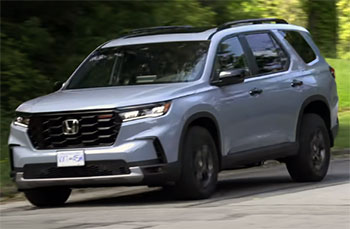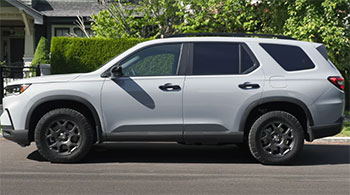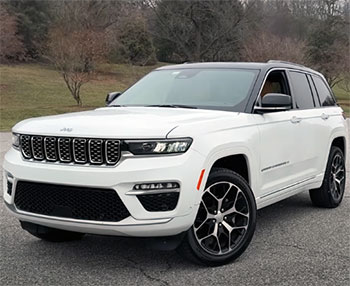I’ve always been fascinated by SUVs that balance family-friendly practicality with adventure-ready grit, and the 2025 Honda Pilot and Jeep Grand Cherokee are two heavyweights in this arena.
As someone who’s spent time behind the wheel of both, I’m here to share a detailed, first-person comparison to help you decide which midsize SUV suits your lifestyle. Whether you’re hauling kids to soccer practice or craving an off-road escape, this article breaks down their performance, comfort, tech, and more, weighing pros and cons to guide your choice.
Comparison Table: Honda Pilot vs. Jeep Grand Cherokee
| Feature | 2025 Honda Pilot | 2025 Jeep Grand Cherokee |
|---|---|---|
| Starting MSRP | $41,650 | $38,490 |
| Engine | 3.5L V6, 285 hp | 3.6L V6, 293 hp |
| Fuel Economy | 19/27 MPG (city/highway) | 19/26 MPG (city/highway) |
| Seating Capacity | Up to 8 | Up to 5 |
| Cargo Space | 18.6 ft³ (seats up), 87.0 ft³ (max) | 37.7 ft³ (seats up), 87.0 ft³ (max) |
| Towing Capacity | 5,000 lbs | 6,200–7,200 lbs |
| Infotainment | 9-inch touchscreen, wireless Apple CarPlay/Android Auto | 10.1-inch touchscreen, Apple CarPlay/Android Auto, optional passenger screen |
| Safety Rating | NHTSA 5-star, IIHS Top Safety Pick+ | NHTSA 4.66-star, IIHS Top Safety Pick |
| Off-Road Capability | AWD available, TrailSport trim | Advanced 4×4 systems, Trailhawk trim |
My Experience With the Honda Pilot

Driving the 2025 Honda Pilot felt like slipping into a reliable, no-nonsense companion.
Its redesigned exterior, with a bold grille and sleek lines, gives it a modern, almost rugged charm that caught my eye.
Inside, the cabin feels like a minivan in disguise, offering room for up to eight passengers and a layout that screams practicality.
I spent a week with the TrailSport trim, which adds all-terrain tires, a slight suspension lift, and skid plates for a touch of off-road flair.
While it’s not a hardcore off-roader, it handled light trails with confidence, making it a versatile choice for families who occasionally venture off pavement.
The 3.5L V6 engine, producing 285 horsepower, delivered smooth and predictable power. It’s not a speed demon, but it felt responsive enough for daily commutes and highway merges. The 10-speed automatic transmission was a highlight, shifting seamlessly whether I was navigating stop-and-go traffic or cruising at 70 mph. Handling surprised me for an SUV this size—the Pilot’s tight turning radius (39.4 feet) made parking in tight urban lots a breeze, and the suspension soaked up potholes with ease.
Fuel economy, at 19 MPG city and 27 MPG highway, was respectable but not class-leading. I found myself wishing for a hybrid option, especially after seeing competitors like the Toyota Highlander offer better efficiency.
Interior Comfort and Family-Friendly Features
The Pilot’s interior is its strongest suit. With 152 cubic feet of passenger volume, it feels cavernous. The second-row captain’s chairs in the Elite trim were a hit with my passengers, offering 40.8 inches of legroom and easy access to the third row. The removable center seat, which doubles as a console, was a clever touch—I stowed it in the underfloor trunk bin during a weekend camping trip, freeing up space for extra gear. The third row, while functional, felt snug for adults (31.9 inches of legroom), but my kids had no complaints. Cargo space is generous, with 18.6 cubic feet behind the third row and up to 87.0 cubic feet with all seats folded. I packed in luggage, a cooler, and sports equipment without breaking a sweat.
The 9-inch touchscreen infotainment system was intuitive, with wireless Apple CarPlay and Android Auto connecting instantly. Honda’s CabinTalk in-car PA system was a game-changer for communicating with passengers in the back—perfect for family road trips when I didn’t want to shout over music. The safety suite, including adaptive cruise control, lane-keeping assist, and Traffic Sign Recognition, felt polished and reliable, earning the Pilot a 5-star NHTSA rating and an IIHS Top Safety Pick+. During a rainy drive, the blind-spot monitoring and rear cross-traffic alert helped me navigate congested roads with confidence.
Driving Dynamics and Trim Options

The Pilot’s driving dynamics lean toward comfort over sportiness.
Its suspension balances a soft ride with enough composure to handle curvy backroads without feeling floaty.
I took it on a winding mountain road, and while it’s no sports car, the steering was precise, and body roll was minimal for an SUV of its size.
The all-wheel-drive system, standard on higher trims like the TrailSport, provided decent traction on wet roads and gravel paths, but it’s not designed for extreme off-roading.
If you’re looking for a rugged adventure, the Pilot’s limits become apparent.
Honda offers five trims—Sport, EX-L, Touring, TrailSport, and Elite—ranging from $41,650 to around $53,000.
The base Sport trim feels basic, with cloth seats and a smaller 7-inch touchscreen, but stepping up to the EX-L or Touring adds leather, a larger screen, and premium features like a power liftgate.
The TrailSport, my test model, strikes a nice balance with its off-road tweaks and family-friendly amenities, while the Elite feels like a luxury SUV with heated and ventilated seats. Each trim adds value, but I recommend skipping the base model to get the full Pilot experience.
Real-World Usability
In daily use, the Pilot excels as a family hauler. I used it for school drop-offs, grocery runs, and a weekend getaway, and it never felt out of place. The abundance of storage cubbies, including a massive center console, kept my family’s clutter organized. The second-row USB ports and optional rear entertainment system kept my kids entertained on long drives. Towing a small trailer (up to 5,000 pounds) was manageable, but I noticed the engine working harder than I’d hoped under load. For families prioritizing space, safety, and reliability, the Pilot is tough to beat, though its off-road capabilities and fuel efficiency leave room for improvement.
Read More: My Thoughts On Acura MDX Vs. Jeep Grand Cherokee
Pros Of the Honda Pilot
- Spacious Interior: The Pilot’s 152 cubic feet of passenger volume and up to eight seats make it a family favorite. The second row’s 40.8 inches of legroom and flexible seating options, like the stowable center seat, easily accommodated three car seats during my test. It’s a carpooler’s dream.
- Top-Notch Safety: The 5-star NHTSA rating and IIHS Top Safety Pick+ reflect a robust safety suite. Adaptive cruise control, lane-keeping assist, and Traffic Sign Recognition worked seamlessly, giving me confidence in heavy traffic or bad weather.
- Reliability Reputation: Honda’s reliability is legendary, with Consumer Reports scoring the Pilot 37 points higher than the Grand Cherokee. J.D. Power’s 2024 Initial Quality Study ranks Honda above average, making the Pilot a worry-free long-term investment.
- User-Friendly Tech: The 9-inch touchscreen is crisp and responsive, with wireless Apple CarPlay and Android Auto connecting instantly. The CabinTalk PA system was a lifesaver for chatting with kids in the back without yelling.
- Smooth Ride Quality: The suspension absorbs bumps effortlessly, and the 39.4-foot turning radius makes tight maneuvers a breeze. I navigated crowded parking lots and city streets with minimal effort.
- Versatile Cargo Space: With 18.6 cubic feet behind the third row and 87.0 cubic feet max, the Pilot swallowed everything from groceries to camping gear. The underfloor storage bin kept valuables hidden and secure.
- Flexible Trim Options: Five trims offer something for every budget, from the practical EX-L to the upscale Elite. I found the TrailSport’s balance of ruggedness and comfort particularly appealing for family adventures.
The Pilot’s strengths make it a standout for families. Its spacious, practical interior and top-tier safety features create a stress-free driving experience. The tech is intuitive, and Honda’s reliability gives peace of mind for years of ownership. While it’s not the most thrilling SUV, its smooth ride and thoughtful design make it a reliable partner for daily life and occasional getaways.
Cons Of the Honda Pilot
- Limited Off-Road Capability: The TrailSport trim adds all-terrain tires and a slight lift, but it’s no match for true off-roaders like the Grand Cherokee. I managed light trails, but steep inclines or rocky terrain exposed its limits.
- No Hybrid Option: With only a V6 powertrain, the Pilot’s 19/27 MPG feels average. Competitors like the Toyota Highlander offer hybrids for better efficiency, and I missed that option during long drives.
- Base Trim Feels Basic: The $41,650 Sport trim lacks premium touches like heated seats or a larger touchscreen. I felt compelled to upgrade to the EX-L or Touring for a more complete package, which raises the price.
- Third-Row Tightness: The third row’s 31.9 inches of legroom is cramped for adults. My taller friends struggled on a group trip, making it better suited for kids or short rides.
- Less Powerful Engine: The 285-horsepower V6 is smooth but lacks the punch of the Grand Cherokee’s optional engines. Towing a 5,000-pound trailer felt sluggish compared to competitors.
- Higher Starting Price: At $41,650, the Pilot costs more than the Grand Cherokee’s $38,490 base price. For budget buyers, this gap is noticeable, especially with the Pilot’s modest performance.
- Noisy Cabin at High Speeds: On highways, I noticed more wind and road noise than expected for a family SUV. It wasn’t intrusive, but it detracted from the premium feel of higher trims.
The Pilot’s drawbacks are most apparent for those seeking adventure or efficiency. Its off-road capabilities are limited, and the lack of a hybrid option feels like a missed opportunity. The base trim’s lackluster features and higher starting price may deter budget-conscious buyers, but its family-friendly design still shines.
My Experience With the Jeep Grand Cherokee

The 2025 Jeep Grand Cherokee has a rugged charisma that’s hard to resist. Its iconic seven-slot grille and muscular stance made it a head-turner during my test drive.
I spent time with the Overland trim, which blends luxury with off-road grit, featuring leather seats, a 10.1-inch touchscreen, and a premium Alpine audio system.
The standard 3.6L V6, delivering 293 horsepower, felt peppier than the Pilot, especially during quick accelerations.
The 8-speed automatic transmission shifted crisply, making city and highway driving effortless.
The Grand Cherokee’s off-road credentials are its biggest draw.
I tested the Trailhawk trim on a muddy, rocky trail, and its three 4×4 systems (Quadra-Trac I, II, and Quadra-Drive II) tackled the terrain with ease.
The Selec-Terrain system let me switch between modes like Mud, Rock, and Snow, and the 24-inch water-fording capability handled a shallow stream crossing confidently.
Towing was another strength—up to 7,200 pounds with the optional 5.7L HEMI V8, far surpassing the Pilot’s 5,000-pound limit. Fuel economy (19/26 MPG) was similar to the Pilot, but I noticed it dipped during aggressive off-road sessions.
Interior Comfort and Technology
The Grand Cherokee seats five, which felt limiting compared to the Pilot’s eight-seat capacity. Still, the 37.7 cubic feet of cargo space behind the rear seats was ample for weekend gear, and folding the seats yields 87.0 cubic feet, matching the Pilot. The Uconnect infotainment system, with its 10.1-inch touchscreen, was a highlight—responsive, colorful, and packed with features like wireless Apple CarPlay and Android Auto. The optional passenger screen was a hit with my co-pilot, who used it to manage navigation and music without distracting me. Higher trims like Summit add luxury touches like quilted leather and a McIntosh audio system, making the cabin feel upscale.
Safety features, including adaptive cruise control, blind-spot monitoring, and automatic emergency braking, were effective, though the NHTSA’s 4.66-star rating slightly trails the Pilot’s 5 stars. I appreciated the night vision feature on higher trims, which helped spot wildlife during a dusk drive. The interior, while premium, felt less family-oriented than the Pilot, with fewer storage cubbies and no in-car PA system for rear passengers.
Driving Dynamics and Trim Options
The Grand Cherokee’s driving dynamics prioritize stability over comfort. Its firm suspension handled off-road challenges well but felt stiffer on highways, where I noticed more road imperfections than in the Pilot. The steering was precise, and the 4×4 systems provided excellent grip on wet roads. For thrill-seekers, higher trims like the SRT or Trackhawk offer V8 engines with up to 707 horsepower, turning the Jeep into a performance beast—something the Pilot can’t match.
Jeep offers six trims—Laredo, Altitude, Limited, Overland, Trailhawk, and Summit—starting at $38,490 and climbing to over $60,000 for the Summit Reserve. The base Laredo is well-equipped with a 10.1-inch touchscreen and basic safety features, while the Trailhawk caters to off-roaders with skid plates and all-terrain tires. The Overland and Summit trims feel luxurious, but the price escalates quickly. I found the Overland’s balance of tech, comfort, and off-road capability the most appealing for versatile use.
Real-World Usability
In daily driving, the Grand Cherokee shines for solo or small-group adventures. I used it for a weekend camping trip, and the cargo space easily fit tents, coolers, and hiking gear. The towing capacity made hauling a trailer for kayaks a breeze, and the off-road modes gave me confidence on rough backroads. However, with only five seats, it felt less practical for large families. The firm ride was noticeable on long drives, and the cabin’s noise levels were slightly higher than the Pilot’s. For outdoor enthusiasts or those towing heavy loads, the Grand Cherokee is a powerhouse, but it’s less ideal for daily family duties.
Pros Of the Jeep Grand Cherokee
- Superior Off-Road Capability: The Trailhawk’s 4×4 systems and 24-inch water-fording ability made muddy trails and rocky paths a breeze. I felt unstoppable tackling terrain the Pilot couldn’t handle.
- Powerful Engine Options: The 3.6L V6 (293 hp) offers more pep than the Pilot, and optional V8s (up to 707 hp) deliver thrilling performance. Highway passing was effortless in my test drive.
- Higher Towing Capacity: With up to 7,200 pounds of towing, the Jeep is a beast for trailers or boats. I towed a camper with ease, outclassing the Pilot’s 5,000-pound limit.
- Advanced Infotainment: The 10.1-inch Uconnect system is sleek and user-friendly, with wireless Apple CarPlay/Android Auto and an optional passenger screen that my co-driver loved for navigation.
- Premium Interior Options: Higher trims like Overland and Summit offer leather seats and premium audio systems, creating a near-luxury experience. The cabin felt upscale and inviting.
- Lower Starting Price: At $38,490, the Grand Cherokee is more affordable than the Pilot’s $41,650, making it a better value for budget-conscious buyers seeking performance.
- Iconic Design: The seven-slot grille and muscular stance give the Jeep a timeless appeal. I received compliments everywhere I parked it, adding to its charm.
The Grand Cherokee’s strengths cater to adventure-seekers and those craving power. Its off-road capabilities, towing prowess, and advanced tech make it a versatile SUV for thrill-seekers and luxury lovers alike. The lower starting price is a bonus for value-driven buyers.
Cons Of the Jeep Grand Cherokee
- Limited Seating Capacity: With only five seats, the Grand Cherokee lags behind the Pilot’s eight-seat option. I struggled to fit extra passengers for group outings.
- Lower Reliability Ratings: Jeep’s reliability trails Honda, with Consumer Reports scoring the Grand Cherokee at 8.6/10 versus the Pilot’s 9.2/10. I worried about potential maintenance costs.
- Firm Ride Quality: The suspension, tuned for off-roading, makes highway drives less comfortable. I felt more bumps than in the Pilot, especially on long trips.
- Smaller Third-Row Option: The Grand Cherokee L’s third row is cramped (38.2 inches of second-row legroom) and only seats seven. The Pilot’s third row is more spacious.
- Fuel Economy Lags Slightly: The 19/26 MPG rating feels less efficient during aggressive driving. I stopped for gas more often than expected on spirited drives.
- Higher Trim Costs: Top trims like Summit Reserve exceed $60,000, outpacing the Pilot’s price range. I found the cost of premium features steep.
- Less Family-Friendly: Without features like an in-car PA system or abundant storage cubbies, the Jeep feels less tailored to large families than the Pilot.
The Grand Cherokee’s cons are significant for family buyers or those prioritizing reliability. Its smaller cabin, firmer ride, and lower reliability ratings make it less practical for daily use, though its adventure-ready nature is unmatched.
Read More: My Thoughts On GMC Terrain Vs. Ford Escape
Frequently Asked Questions (FAQ)
It depends on your needs. The Pilot excels for families with its spacious interior, reliability, and safety ratings. The Grand Cherokee is better for adventure-seekers, offering superior off-road capability and towing.
Yes, Hondas generally outrank Jeeps in reliability. Consumer Reports gives the Pilot a 9.2/10 reliability score versus the Grand Cherokee’s 8.6/10, and J.D. Power ranks Honda higher in initial quality.
The Jeep Grand Cherokee L, with its three-row seating for up to seven, is the closest match to the Pilot’s family-friendly design, though the Pilot offers more interior space.
The Grand Cherokee’s popularity stems from its rugged off-road capability, powerful engine options, and premium features. Its iconic design and versatility appeal to adventure enthusiasts and luxury seekers alike.
Conclusion: For You, the Honda Pilot or Jeep Grand Cherokee?
Choosing between the 2025 Honda Pilot and Jeep Grand Cherokee comes down to what you value most. If you’re after a reliable, spacious SUV for family duties, the Pilot is your match. Its roomy cabin, top safety scores, and Honda’s trusted reliability make it a practical choice for daily life. But if you crave adventure, the Grand Cherokee’s off-road prowess, higher towing capacity, and upscale tech make it a thrilling companion. Test-drive both to feel their vibe—you’ll know which one fits your journey.

